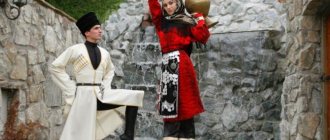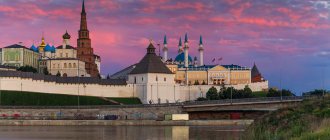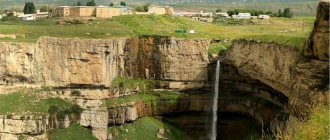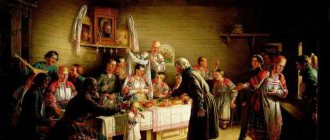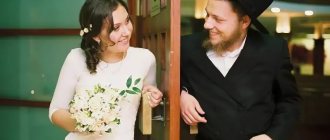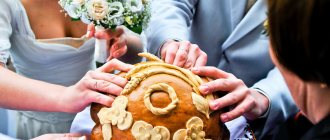Name
Researchers do not have a consensus on the origin of the name of the people. Some associate the version of the appearance of the ethnonym with Idar Kabardei, a semi-legendary prince, under whose leadership the people occupied the territories of the Terek basin in the 15th century. According to another version, the prince’s name was Kabarda Tambiev - he is considered the founder of the Kabardian ethnic group. According to legend, the prince moved from the Western to the Northern Caucasus along with one of the branches of the Circassians. Kabardians, like other Circassians, call themselves Adyghe. The ethnonym has ancient roots; researchers could not come to a consensus regarding its appearance. According to one version, the word means “children of the sun.”
Matchmaking
It all starts with the groom's relatives helping him find a girl who will suit him as a bride. Next, the groom and his closest relatives head to the girl’s house, hoping that her father will agree to marry off his daughter. If the answer is positive, they begin to discuss the topic regarding the bride price. We must immediately warn you that the groom was not always lucky to receive a blessing from his future father-in-law the first time. Often he sent the annoying guy away with nothing.
The goal could be achieved after the second, third, etc. approach Apparently, in this way the firmness of intentions was tested. This is exactly how a Kabardian wedding begins, in Nalchik for example.
Where they live, number
During their heyday, the Kabardians occupied vast territories of the Central Ciscaucasia. The region of settlement was named Kabarda, the lands of which were divided into Small and Big Kabarda. There are no exact data on the number of Kabardians before the Caucasian War; rough estimates indicate 35,000 households, which suggests a total number of inhabitants of at least several hundred thousand people. A sharp decline in population occurred at the beginning of the 19th century. The destructive Caucasian War and a severe plague epidemic almost completely devastated Lesser Kabarda and seriously reduced the number of inhabitants of Bolshaya. In 1825, Kabardians were included in Russia. At the end of the Caucasian War, along with other Adyghe peoples, they were forcibly evicted outside the Russian state, mainly to Turkey.
According to the 2010 census, the number of Kabardians in Russia is 517,000 people. Most of them, 490,000 people, live on the territory of Kabardino-Balkaria, making up 57% of the population of the Republic. Number of Kabardians in other regions of Russia:
- Stavropol Territory - 7993 people.
- Moscow - 3698 people.
- North Ossetia - 2802 people.
- Moscow region - 1306 people.
- St. Petersburg - 1181 people.
- Krasnodar region - 1130 people.
Due to deportations, as a result of the Caucasian War and repressions of 1944, a significant part of the ethnic group lives abroad. The largest diaspora of Circassians, including Kabardians, is located in Turkey, according to some sources, considered the third largest people of the state. Circassian diasporas have been recorded in Syria, Lebanon, Saudi Arabia, Jordan, Germany, the USA, and North Africa.
Language
Kabardians speak the Adygebze language, scientists call it the Kabardino-Circassian language as part of the Abkhaz-Adyghe family. Some linguists consider the Adyghe and Kabardino-Circassian languages to be dialects of a single language common to the Adygs. Kabardians agree with the version, as evidenced by the self-name of the language and the possibility of communicating in it with representatives of other Adyghe peoples. Researchers have not found traces of Kabardian writing: legends were passed on from mouth to mouth. If it was necessary to transmit text messages, Arabic graphics were used. In 1885, Umar Bersey compiled the first Circassian primer. Since 1936, the Cyrillic-based alphabet has been used. The native language is taught in the primary classes of local schools. Along with Russian, Kabardino-Circassian is widely used in the everyday life of the people.
Story
The ancestors of the Circassians are the Meotian tribes that occupied the Black Sea and Azov territories in the first millennium BC. Linguistic similarities suggest that the tribes of the ancient Kaskas and Hutts, who inhabited Anatolia and the Southern Black Sea region from the third millennium BC, participated in the formation of the ethnos. The first mention of Kabardians dates back to the 10th century. Constantine Porphyrogenitus described Kasakhia, the country of the Kasogs, located near Alania, Papagia, and Zikhia. By the 16th century, information about the people became more accurate, the area of residence was localized in three directions:
- The foothill and flat territories of the left tributaries of the Terek are a historical area of residence called Kabarda.
- The right bank of the Terek from the mouth of the Sunzha to the mouth of the Kurp is Malaya Kabarda.
- The lower reaches of the Terek, north of Kabarda, which included the territory of Mount Beshtau (Pyatigorsk) - in Russian documents received the name “Land of the Pyatigorsk Cherkassy”, were called Greater Kabarda.
Since the 16th century, strong ties have been established with the Moscow state, due to the goal of influencing a common enemy: the Crimean Khanate. The Kabardian prince Temryuk Idarov (also Idarovich) played a significant role in establishing friendly relations with Moscow. He managed to unite neighboring peoples by drawing up the first embassy in 1552 to Ivan the Terrible. In subsequent years, together with Grozny, the Kabardians took part in the capture of Kazan, Temryuk, Taman, and Astrakhan. The relationship was cemented in 1561 by the marriage of Ivan the Terrible and the daughter of Temryuk Idarov, who after baptism received the name of Tsarina Maria Temryukovna.
After 10 years, Ottoman influence was restored, and a period of feudal fragmentation began in the Kabardian region. Local princes continued to influence neighboring peoples, who adopted the way of life, costume, customs, culture, and rules of conduct of the Kabardians. Noble representatives of the clans entered the Russian service and came to the aid of the Tsar during the Time of Troubles. Prince Cherkassky, as the closest relative of Maria Temryukovna and who was listed first in the Council of the Second Militia in terms of localism, was one of the contenders for the throne. However, the Zemsky Sobor of 1613 settled on a neutral candidate - Mikhail Romanov, whose reign marked the beginning of the 300-year reign of the great Romanov dynasty.
In 1681, Cherkassky agreed on eternal peace with the Ottoman Empire, and in 1739, the Russian Empire abandoned its claims to the territory. Until 1825, when during the Caucasian War the region was re-annexed to Russia, Kabarda existed as an independent state.
Appearance
Anthropologically, Kabardians belong to the so-called Pyatigorsk mix, which is a mixture of Caucasian and Pontic types. Distinctive appearance features include:
- tall or average height;
- athletic build;
- wide face;
- prominent cheekbones;
- straight eyebrows;
- horizontal position of the eyes;
- the nose is straight or with a hump, the tip is horizontal;
- eyes brown, gray, black;
- straight, coarse hair;
- hair is developed.
Researchers of the 16th-19th centuries. noted the attractive appearance of the Kabardians, calling the representatives of the people one of the most beautiful in the Caucasus. The men were distinguished by their athletic build, broad shoulders, agility, and agility. From an early age, boys were taught how to handle weapons and horses, wrestling, and horse riding. Thanks to this, children grew into physically strong, resilient, fit young men. Girls from the age of 12 began to use a corset with wooden inserts in the front. The item of clothing was worn day and night and was supposed to be removed on the wedding night. The use of a corset ensured ideal posture, a slender figure with a thin waist and small breasts: such an appearance was considered the standard in the Caucasus.
Official registration of marriage
When the marriage is registered by the Imam, you can begin to prepare for the official part of the holiday. After the first wedding night, it is customary to show the sheets to guests, although this is not within the framework of modern moral principles. The first two days before preparing for the wedding, the groom's relatives actively celebrate the upcoming celebration. On the third day, the young couple’s relatives join them, bringing with them a dowry. They take the best wine and slaughter a ram. The parents of the newlyweds are not present at the official part of the wedding. When the marriage certificate is received, everyone goes to the groom's house to celebrate the occasion. Only men from both sides are present at the table. They congratulate the groom, introduce him to the elders, and then turn off the lights and try his headdress. The guy shouldn't let this happen. When the bride meets her husband's relatives, a ram skin is brought to the center of the hall. The girl stands on top of it and must hold on while the skin is pulled out from under her feet. This is followed by dancing and showering the bride with small money and millet. According to etiquette, women and men have fun separately. And the bride should be hidden under a veil from the gaze of other men. Previously, a Kabardian wedding lasted a whole week. Now views have changed, but this is still the most long-awaited day in the life of young people, their friends and relatives.
Kabardian weddings are considered one of the most fun and spectacular national family holidays. It is noteworthy that they always present various kinds of conflicts and quarrels. It's not a matter of poor organization. The tradition of arguing at this celebration appeared several years ago; it is based on ancient national customs.
Cloth
The Kabardian princes were considered the trendsetters of the Caucasus. The traditional costume consisted of trousers, morocco tunics, a high-necked shirt with buttons, a beshmet, a Circassian coat, and a hat. An obligatory element of the costume is a richly decorated inlaid belt or saber girdle for edged weapons: a dagger, a checker, a saber. The Circassian coat of black, brown, red, white color was complemented by gazyrs and a bib. In the cold season and on hikes they wore burqas, and for everyday wear they used sheepskin coats. The women's costume consisted of a tunic-like shirt reaching to the floor, trousers, and a swing dress. The latter could be casual and festive: formal outfits were decorated with gold and silver embroidery, skillfully crafted silver belts, and jewelry made of precious metals. The girls complemented the outfit with a tall hat with gold embroidery. After marriage, it was replaced with a black scarf, the ends of which were wrapped around the neck and tied on the head. An elegant openwork scarf of a light shade was worn on top.
Life
Social organization
Kabardians were divided into five classes or estates:
- Princes. Before the Caucasian War, the top power was made up of princely families; according to some sources, there were six of them. Each clan owned vast territories of Kabarda, had an army, overlords, peasants, servants, and slaves. From among the princes, in different periods, a supreme prince was chosen, who represented the interests of Kabardians outside the historical region of residence.
- Nobles, or uzdeni. Divided into three categories based on birthright and amount of wealth. The first and second are recognized vassals of the prince, noble families with great names. Still others can be compared to the Polish small gentry, who have weight and a certain wealth, but are not included in the first-line elite.
- Clergy: mullahs and imams. They took an active part in solving public issues.
- "Thokotli" peasants. They belong to princes and uzdens, have their own land or are leased from the owners. They make up the main population of Kabarda: they are engaged in agriculture, cattle breeding, fishing, and ensure the well-being of the ruling elite.
- Slaves, or Yasyrs. Slaves were bought and used as captives as lures. The lowest, powerless layer of the population. Most were used as servants in noble houses.
Family life
Until the 19th century, Kabardians lived in a large patriarchal family, the average number was about 60 people. The head of the family was the eldest man, there was a saying: “The power of the eldest is equal to the power of God.” Honoring elders is one of the fundamental traditions of Kabardians. The oldest man, even if he was lower in class, always sat in the place of honor at the table. Other men sat down later or remained standing; sons did not have the right to eat with their father at the same table. Often in everyday life, the head of the family shared food only with his grandchildren, for whose upbringing he was responsible.
The eldest woman was considered the main one in solving household and economic affairs, and had complete power over children and daughters-in-law. Women were in a dependent position on men, but they enjoyed respect and honor and did not experience physical or moral violence. Islam allowed polygamy, but family values prescribed Kabardians to have one life partner. Divorce was viewed negatively, although men could file a request - without explanation, and women - due to infidelity or due to male impotence. There was a proverb: “The first wife is your wife, the second wife is your wife.” Researchers are ambivalent about the ritual of avoidance, which forbade daughters-in-law to talk to their fathers-in-law. There were especially strict rules regarding communication with the father-in-law. In the first years, usually before the birth of their first child, the young wife was required to cover her face in the presence of her husband’s father; she was forbidden to speak first, look into the eyes, stand with her back or opposite: only half a turn. A number of researchers consider this, coupled with the custom of bride price and arranged weddings, to be oppression of women. Others consider avoidance to be a sign of respect for daughters-in-law, a way of life that has been formed since ancient times, helping a large family to avoid interpersonal conflicts and contradictions. Avoidance also affected husband and wife, parents and children, son-in-law and spouse's parents. We did not see the latter for a month after the wedding: after the young wife was brought to visit her father’s house, the ban was lifted. The spouses did not call each other by name; it was shameful to talk about a wife or husband in front of strangers. If necessary, they would say “the son of so-and-so,” “their daughter.” The display of tender feelings was considered a disgrace; it was forbidden to remain alone in the same room during the day: spouses met at night or in the presence of other relatives.
Avoidance affected the relationship between parents and children, mostly the father. A man was forbidden to pick up a child in his arms in the presence of strangers, use gentle words, call him by name, play, caress, or kiss. Since the mother had the responsibility of caring for the baby, she was less affected by avoidance. However, according to tradition, during the first carrying out of the cradle into the common living room, the woman did not look at the child and did not approach him. The mother was forbidden to publicly mourn her child if he died. Strict avoidance, coupled with the need to create strong inter-clan and inter-tribal relationships, gave rise to the tradition of atalism. At an early age, one or more children from a family were given to be raised by an equal or slightly less noble family of their own or someone else's people. The atalyks fully provided for the pupils, gave them education and life skills. With the onset of adulthood, boys and girls were returned, provided with weapons, a horse, and outfits. Families gave rich gifts to the atalyks; often the bride price for the girl was sent to the teachers.
Classes
The traditional occupations of Kabardians were agriculture and cattle breeding. They sowed wheat, barley, just corn. They were engaged in gardening, gardening, and beekeeping. They raised small and large cattle and used transhumance technology. Buffaloes were used as draft animals. Kabardians became famous as excellent horse breeders, who bred the famous Kabardian horse-drawn breed. Horses were distinguished by their extraordinary endurance, efficiency, fearlessness, and resistance to disease, which made them indispensable on long campaigns, crossings, and battles. Being an aboriginal breed, the Kabardian horse perfectly maintained balance in mountainous areas, on rocky, slippery paths, descents, and ascents.
Modern traditions of Kabardian wedding
A mandatory custom of modern weddings is bride kidnapping. The girl is received by relatives in their home, then her parents come to her and ask her consent to marriage. If the answer is yes, the young couple is considered husband and wife. This didn't happen before. The marriage is registered by the Imam - a Muslim priest. Another difference of modern times is the location of the wedding celebration. Previously, the celebration was celebrated at home, but now it is increasingly celebrated in a restaurant. If a girl does not want to get married, she has the right to calmly go to her parents’ house. In the old days, a man could simply steal the woman he liked, leaving her no choice.
Religion
From the XV-XVI centuries. Kabarda is captured by Islam. A number of researchers believe that Orthodoxy was previously practiced in the region, others talk about the predominance of paganism. Echoes of traditional beliefs have survived to this day, for example, the ritual of making rain. They revered the thunder god Shible: after the first thunder in the spring, they poured water on the granaries with a request for a bountiful harvest in the new season. The god of agriculture and fertility, Tkhashkho, was considered one of the most revered in the pantheon. The full cycle of agricultural rituals is associated with it: folk festivals with animal sacrifices before plowing, the festival of the first furrow, the end of plowing, and harvesting. There was a cult of trees, the wolf was considered a sacred animal: the bones, teeth, and veins of the animal were considered amulets.
History of the origin of the Balkar people
The early history of this Caucasian people is shrouded in mystery. It is known that during its existence it acquired Turkic, Alan-Ossetian, Svan and Adyghe ethnic components. There are several versions about the origin of the Balkars.
The French scientist G. Yu. Klaproth, who studied the peoples of the North Caucasus at the beginning of the 19th century, believed that the ancestors of the Balkars were the Khazars who moved to the mountain gorges from the Golden Horde city of Madzhar, destroyed by the troops of Tamerlane in 1395. According to other scientists, the high-mountainous Caucasian peoples are descendants of Tamerlane’s warriors who settled in the mountains after the victory over Tokhtamysh.
Russian historians and ethnographers believe that they descended from the ancient Caucasian Bulgarians or separated from the peoples who were under Mongol rule in the 16th century. All versions are based on folk legends and have no direct evidence. Karachay-Balkar writing appeared only in the 18th century, so true historical information about their appearance in the Caucasus has not reached our days.
Since ancient times, they settled in the foothills and mountains, less often on the plains. Houses made of stone and clay were built crowded together in places difficult to reach for attack. The basis of the economic life of the Balkars was transhumance cattle breeding and arable farming, which was reflected in the kitchen and served the development of leather craft.
Each settlement consisted of several clans. Representatives of the upper classes lived in multi-room houses, peasants lived in one-room houses. Housing was divided into two halves – male and female. Houses were heated and lit using an open fireplace. The custom persisted for a long time, according to which only on one specific day could one give neighbors fire from one’s hearth to rekindle their extinguished hearth.
Balkar society had a multi-level hierarchy, which has been unofficially preserved to this day. Nobility - taubi, princes. One step below the bridle is the nobility. The less privileged class, the Karakish, performed not only noble duties, but also labor ones. This class was considered heterogeneous and was divided into several categories.
The next ones are Azats - farmers who worked on the lands of the Taubi. Even lower are the Chagars, who have minor rights. Kasags and Karaushis occupied the lowest level and had no rights. Representatives of each class had their own set of rules.
Traditions
The Kabardian wedding ritual included many stages, which ensured its significant duration: from several months to several years. The cycle included the following activities:
- Matchmaking. Relatives on the male side chose a bride worthy of her status, and they sent matchmakers to her parents. From the first time, the conversation did not always end with a positive answer: sometimes it took several months to wait for consent.
- Agreeing on the amount of dowry. Negotiations were made slowly, often with disputes and bargaining. Rich families knew the required ransom amount: a minimum of 30 parts. Eight were a servant, a helmet, chain mail, a saber, a guard, a good and an ordinary horse, and 8 bulls. The remaining 22 parts were measured by the heads of animals: rams, bulls, buffaloes.
- Bridesmaids and engagement. On the appointed day, the future bride and groom met for the first time in the bride's house, where the acquaintance took place. According to Islamic traditions, a betrothal ceremony was held.
- Payment of the share of the dowry. Depending on the financial situation of the young man’s family, the time for collecting the bride price was agreed upon. When most of the ransom was collected, it was handed over to the bride's relatives, after which the exact wedding date was set.
- Conclusion from the bride's father's house. The girl was dressed in a formal wedding suit, covering her head and face. The groom's friends arrived in a noisy wedding train to pick up the bride. Friends and relatives jokingly asked for a ransom, upon receiving which they released the bride.
- "Hide" the bride and groom in different other people's houses. The bride was brought to the house of one of the groom's friends, and he himself settled in the house of another friend. The future husband came to the girl at night, the owner of the house acted as a guard, responsible for the safety of the future spouses with his life. This situation continued for a month.
- Moving to my husband's house. The bride was secretly brought to the groom's house, settled in a room that then became the home of the young family. For a week, the girl did not leave the room and did not communicate with anyone. At this time, the groom was communicating with relatives and praising his future daughter-in-law.
- Rite of reconciliation with relatives. The ceremony of reconciliation between the groom's parents and daughter-in-law took place after her solemn exit from the room. The eldest woman in the house smeared the girl’s lips with oil and honey, sprinkled them with sweets: so that life would be full and sweet. Afterwards a general celebration was held, which lasted several days.
The wedding cycle was completed by numerous rituals of introducing the daughter-in-law to her relatives, home, and household.
Traditions and customs
Until the end of the 19th century. transhumance, arable farming, field farming, beekeeping, etc. played a significant role in the life of the Kabardian people. Horse breeding was of particular importance for the Kabardians. Since the 16th century. The Kabardian breed of horses, bred by crossing steppe horses and stallions of eastern blood, was famous in many countries. The famous horses were distinguished by exceptionally strong hooves, thanks to which they easily climbed narrow mountain paths and overcame snow-covered passes. Traditionally, the people followed the custom of branding young horses with a red-hot “signet”: the ancestral sign - tamga ("damyge") was burned on the horse's croup. Tamga was also placed on various objects (on gravestones, musical instruments, kunatskaya doors, on bowls, etc.).
An important place in the sphere of spiritual culture of the Kabardian people was occupied by the unwritten code of Adyghe khabze (Adyghe etiquette) - a set of strictly regulated traditional norms of customary law, moral precepts and rules of behavior. Many elements of Adyghe etiquette, along with elements of material culture well adapted to military life such as men's clothing, saddle techniques, horse riding, etc., spread widely among neighboring peoples. The Adygs strictly adhered to the customs of hospitality, kunakism, atalychestvo, and blood feud. The guest, whoever he was, enjoyed the protection and patronage of the owner. Anyone who insulted a guest paid the owner of the house a fine of several dozen heads of cattle, and if the guest was killed, the fine increased fivefold, not counting the payment for the crime itself. The Kabardians specially built a house for guests - “kheshchIeshch”. On the basis of hospitality, the institution of “kunachestvo” emerged - an artificial kinship between representatives of different clans, tribes, and nationalities. Kunak was considered a close friend, whose affairs the owner was not only interested in, but also provided him with all kinds of help and protection. Kabardians had kunaks among the Balkars, Russians, Ossetians, peoples of Dagestan, etc., and vice versa. The institution of “atalyk” (in the translation from the Turkic “atalyk” - “fatherhood”) was also widespread among the people - adoption into a family to raise a child, most often a boy. Atalyk took care of his pet as if he were his own son, gave him a Muslim education, taught him horse riding and weaponry, and brought him up in the spirit of Adyghe etiquette. Upon reaching the age of majority, the atalyk returned him to his parental home, equipping him with a horse, weapons and rich clothes. The arrival of the pupil at his home took place in a solemn atmosphere, and the atalyk received cattle, weapons, etc. as a gift. Girls were also given up for education, who were taught various women's handicrafts and housekeeping. At the end of their upbringing, they also returned to their parents' house. The basic principles of Adyghe etiquette - respect for elders, for women, norms of social interaction - still determine the behavior of many Kabardians today.
Until the 19th century The way of life of the Kabardian people was dominated by a large patriarchal family, consisting of three or four generations. The family was managed by the eldest man, and his wife was in charge of the household, supervised the education of boys up to 7-8 years old and girls until they got married. In the 19th century a small family appeared. Prohibitions on marriages within one clan extended to members of the paternal and maternal clans and to numerous types of artificial kinship: milk, adoption, twinning. The wedding ceremony lasted for more than one year. Having chosen a bride, the groom proposed through his relatives (the custom of kidnapping the bride persisted for a long time). If consent was received, the parties agreed on the amount of dowry and the procedure for its payment. After some time, the bride was shown and the newlyweds were betrothed. At the agreed time, the groom contributed part of the bride price, then, a few months later, the ceremony of bringing the bride out of the parental home was performed. Before the wedding, the newlywed stayed (hid) with one of his friends and at night secretly visited his wife, who lived in the house of his relatives. The relationship of the newlywed with the owner of the house where he lived was equated to blood relationship. At the end of a certain period, the newlywed was transported to her husband’s house, in which a specially furnished room was allocated for the newlyweds - “legune”. Until this moment, the groom had avoided meeting his relatives and older fellow villagers. According to tradition, the newlywed had to undergo a ritual of “reconciliation”, which consisted in the fact that after returning to his home, he received parting words from his father and older men of the clan. A week after the wedding, a ritual was performed for the young wife to enter the common room. All elements of a Kabardian wedding were accompanied by music, dancing, songs, horse racing, and games.
The Kabardians solemnly celebrated the birth of a boy with a game-competition (“khueiplyzhkIeryshchIe” - “tying up smoked cheese”). Two high posts with a strong crossbar were dug into the yard, to which smoked cheese was tied, and next to it was an oiled leather rope. The competing guys had to reach the cheese along a rope, bite off a piece and receive a prize for this - a pouch, a case, a bridle, etc. A few days after the birth of a child, the ritual “gushchekhephe” (“tying the child into a cradle”) was held.
Since the 19th century The funeral and memorial customs of the Kabardians were performed according to Muslim rites. Usually the funeral took place the day after the person died. They tried to notify relatives, neighbors, and fellow villagers about this. On the day of the funeral, a ceremony for the remission of sins of the deceased (deur) was performed. To carry it out, the family of the deceased allocated a certain amount of money, which was then distributed among the poor and mullahs. After performing the deur, the deceased was taken out of the house. Only men went to the cemetery. After the funeral, the Koran was read and the clothes of the deceased were distributed to the poor, neighbors and relatives. Every day for forty (today – fifty-two) days, lakums were fried and distributed to neighbors along with sweets, then a large wake was held. Kabardians strictly observe funeral and memorial customs even now. Funeral services are held at 40 and 52 days, at six months and a year.
Since 2011, on the initiative of the International Circassian Association, the International Day of Circassian National Costume has been celebrated. For the first time it was celebrated in the Republic of Adygea, and since 2012 - in the Kabardino-Balkarian Republic. Cherkessk
- the traditional national costume of the Circassians - has long been considered the standard of clothing. The term “Circassian”, derived from the second name of the Circassians “Circassians”, appeared in the 19th century. Circassian is an outerwear in the form of a swinging caftan at the waist, with gathers and a cutout in the chest so that the beshmet is visible. It was usually sewn from dull homespun cloth - one or two colors were strictly selected, mainly the natural colors of wool (brown, black, gray). Elegant white Circassian coats () were worn only by wealthy Kabardians. On the chest of the Circassian coat there were gasyrnitsa - pockets for gasyrs (wooden tubes with a supply of gunpowder). Particular attention was paid to the length and accessories of the Circassian coat, trying not to overload it with unnecessary details. The strict cut of the Circassian coat reflected the ideal of beauty of the Adyghe warrior: a slender, fit figure with broad shoulders and a thin waist, about which it was sung in the song that “if a warrior lies on his side, a cat can run under his waist without hitting him.” The Circassian coat, tightly fitting a man's figure, emphasized his figure and was always worn buttoned up with the sleeves turned back. Only in ceremonial Circassian coats did straight and wide sleeves descend below the wrist. The main value and wealth of the Adyghe was weapons, which were considered a symbol of his freedom, honor and dignity. Therefore, the obligatory accessories of the Circassian were a skillfully made dagger (kame), a saber, and pistols in a rich setting. The weapon was attached to a narrow leather belt decorated with silver plates. A necessary part of the rider's clothing was shIakIue - a long cloak that served as protection from the sun, cold, rain, as well as a bedding and blanket during campaigns. The Circassians wore morocco boots with leggings on their feet, and a hat on their heads. Over time, the Adyghe national costume became the most popular in the Caucasus, and in the 40s. XIX century it was approved as a military uniform of the Cossack troops. Terek, Kuban and Don Cossacks adopted the Adyghe costume, saddling horses, riding style and carrying weapons. Russian Emperor Nicholas II wore a Circassian coat very elegantly, and part of the Russian imperial convoy officially had Caucasian vestments.
At all times, Adyghe girls (Circassian women) were famous for their slender figure and thin waist. The fragility of the girl’s silhouette was contributed by the traditional costume, which included: trousers, a tunic-like shirt, a long swinging dress (fasche) reaching to the toes, silver and gold belts decorated with national ornaments, a cap embroidered with gold and morocco leggings (master - M. A. Khatsukova) . The dress was made of velvet, thick silk or cloth; it had a Circassian cut and was always decorated with a gold embroidery pattern. During ceremonial appearances, representatives of the upper classes wore 12 cm high wooden shoes covered in velvet with bone, silver and gilded decorations - “ph'e vak'e” (master - L. A. Abaeva). These unique shoes are considered the most ancient shoes of Adyghe women, reaching the 19th century. Until now, the national Adyghe costume has been in demand as a work of folk art, carrying the high spirit of the culture of the ethnic group. At the beginning of the twentieth century. under the influence of the neighboring Russian population, Kabardians began to wear blouses (plIe) and skirts (kIe). The sweaters were sewn at the waist, with long sleeves, while the skirts were loose and long. A new trend in modern women's suits has become a combination of classic cut, office silhouette and national Adyghe gold embroidery. Fashion designer Madina Saralp is working in this direction. The famous designer creates exclusive clothes, gracefully combining European aesthetics with the national spirit. Her clothing and accessories lines are very popular not only in Kabardino-Balkaria, but also far beyond Russia.
The basis of the traditional food of Kabardians is boiled and fried lamb, beef, turkey, chicken, broths made from them, sour milk, cottage cheese, cheese, etc. The hallmark of the national cuisine is considered to be “lygur” (lyagur) - smoked and dried lamb or beef (), “zherume” (mutton fat wrapped in tripe with spices), “lybzhye” (meat sauce, variants - dzhedlybzhye, jashlybzhye, etc.). Meat broths (laps), millet decoctions and soups were served after meat dishes and only at the beginning of the 20th century. Some families began to eat soups as first courses. One of the characteristic features of Kabardian cuisine is the presence in it of a large number of sauces, gravies, and seasonings under the general name “shyps”, which are characterized by a pleasant taste and sufficient spiciness. Many of them are high-calorie and can be served as independent dishes (for example, sour cream sauce - “khueyzhyapkhae”). Kabardians always serve pasta (hard-cooked millet porridge without salt) with meat dishes. Along with pasta, churek (unleavened bread made from corn flour in the form of a flatbread), lakum (crumpets), and delen (pies with cheese, cottage cheese, and potatoes) are also consumed. Onions, hot and sweet peppers, herbs, parsley, dill, cilantro and thyme (dzedgyn) are used in large quantities to add spiciness and piquancy to dishes. National delicacies “hyelyue” (halva), “zekIerys”, “tkhuryzh” (brushwood) are served as dessert on the festive table. The national drink is “makhsyme” (buza), which is prepared from millet flour and malt. In the recent past, only the elders drank this intoxicating drink at Kabardian wedding celebrations. A symbolic glass of a hero was awarded to a young man who committed a heroic act. As a rule, he only sipped a glass of courage, which was also considered a sign of good manners. Kalmyk tea was widespread - this was the name given to Kalmyk tea itself and tea with rose hips and some herbs. Black long tea was consumed by wealthy families. Currently, much of what the ancestors of modern Kabardians decorated the table with has been lost or has become part of the category of impersonal Caucasian dishes. At the same time, Kabardian national cuisine, thanks to close contacts with neighbors, was also enriched with dishes of other peoples (yeast bread, pies, pies with various fillings, borscht and others from Russian and Ukrainian cuisine). Under the influence of Ossetians, Kabardians learned to make beer (syre) from barley.
